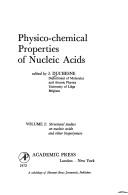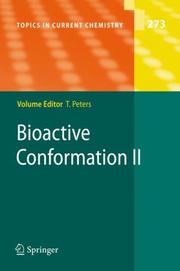| Listing 1 - 7 of 7 |
Sort by
|
Book
ISBN: 0124105505 0323145655 1299473660 9780124105508 Year: 1973 Volume: 29 Publisher: New York (N.Y.) : Academic press,
Abstract | Keywords | Export | Availability | Bookmark
 Loading...
Loading...Choose an application
- Reference Manager
- EndNote
- RefWorks (Direct export to RefWorks)
Crystallography. --- Conformational analysis --- Crystal lattices --- Crystallography --- Crystallographies --- Leptology --- Physical sciences --- Mineralogy --- Crystals --- Crystallography, Mathematical --- Lattice theory --- Twinning (Crystallography) --- Analysis, Conformational --- Molecular rotation --- Lattices --- Conformational analysis. --- Crystal lattices. --- Molecular structure --- Molecular crystals --- Lattice dynamics
Book
ISBN: 0895733439 3527266399 9780895733436 9783527266395 Year: 1989 Publisher: Weinheim: VCH,
Abstract | Keywords | Export | Availability | Bookmark
 Loading...
Loading...Choose an application
- Reference Manager
- EndNote
- RefWorks (Direct export to RefWorks)
Conformational analysis --- Overhauser effect (Nuclear physics) --- Analyse conformationnelle --- Effet Overhauser (Physique nucléaire) --- 543.422.25 --- #WSCH:MACT --- #WSCH:LOSA --- Nuclear magnetic resonance --- Spin-lattice relaxation --- Analysis, Conformational --- Molecular rotation --- Using high frequency electromagnetic waves (radio waves). Nuclear manetic resonance spectroscopy. NMR spectroscopy --- 543.422.25 Using high frequency electromagnetic waves (radio waves). Nuclear manetic resonance spectroscopy. NMR spectroscopy --- Effet Overhauser (Physique nucléaire) --- Conformation --- Spin, nuclear
Book
ISBN: 3030541541 3030541533 Year: 2020 Publisher: Cham, Switzerland : Springer,
Abstract | Keywords | Export | Availability | Bookmark
 Loading...
Loading...Choose an application
- Reference Manager
- EndNote
- RefWorks (Direct export to RefWorks)
The aim of these lecture notes is to propose a systematic framework for geometry and analysis on metric spaces. The central notion is a partition (an iterated decomposition) of a compact metric space. Via a partition, a compact metric space is associated with an infinite graph whose boundary is the original space. Metrics and measures on the space are then studied from an integrated point of view as weights of the partition. In the course of the text: It is shown that a weight corresponds to a metric if and only if the associated weighted graph is Gromov hyperbolic. Various relations between metrics and measures such as bilipschitz equivalence, quasisymmetry, Ahlfors regularity, and the volume doubling property are translated to relations between weights. In particular, it is shown that the volume doubling property between a metric and a measure corresponds to a quasisymmetry between two metrics in the language of weights. The Ahlfors regular conformal dimension of a compact metric space is characterized as the critical index of p-energies associated with the partition and the weight function corresponding to the metric. These notes should interest researchers and PhD students working in conformal geometry, analysis on metric spaces, and related areas.
Geometry. --- Mathematical analysis. --- Analysis (Mathematics). --- Hyperbolic geometry. --- Measure theory. --- Topology. --- Analysis. --- Hyperbolic Geometry. --- Measure and Integration. --- Analysis situs --- Position analysis --- Rubber-sheet geometry --- Geometry --- Polyhedra --- Set theory --- Algebras, Linear --- Lebesgue measure --- Measurable sets --- Measure of a set --- Algebraic topology --- Integrals, Generalized --- Measure algebras --- Rings (Algebra) --- Hyperbolic geometry --- Lobachevski geometry --- Lobatschevski geometry --- Geometry, Non-Euclidean --- 517.1 Mathematical analysis --- Mathematical analysis --- Mathematics --- Euclid's Elements --- Conformational analysis. --- Analysis, Conformational --- Molecular rotation
Book
ISBN: 3319085662 3319085654 1322137544 Year: 2014 Publisher: Cham : Springer International Publishing : Imprint: Springer,
Abstract | Keywords | Export | Availability | Bookmark
 Loading...
Loading...Choose an application
- Reference Manager
- EndNote
- RefWorks (Direct export to RefWorks)
This thesis identifies the turning point in chain length, after which alkanes self-solvate into a folded structure instead of an extended stretched conformation. After this turning point, London dispersion forces rearrange isolated n-alkanes into a particular hairpin-structure, while for shorter chain lengths, a simple stretched conformation is energetically preferred. This thesis can locate the experimental turning point for the first time in an interaction-free manner from measurements of unbranched alkanes at low temperatures in supersonic jet expansions. It contains a detailed analysis of the vibrational Raman spectra of the chain molecules, which is supported by comprehensive quantum chemical simulations. In this way, the detailed balance between inter-chain attraction and conformational flexibility can be quantified.The investigations are complemented by measurements of perfluoroalkanes, and similarities and differences between the compounds are discussed. Furthermore, Nils Lüttschwager determines the stiffnesses (elastic moduli) of two of the most common industrial polymers: polyethylene and polytetrafluorethylene. He uses in this thesis a sophisticated extrapolation to calculate this value from quantities of their building blocks, showing that the single polymer molecules can be as stiff as a rod of steel.
Raman spectroscopy. --- Conformational analysis. --- Cryochemistry. --- Low temperature chemistry --- Thermochemistry --- Analysis, Conformational --- Molecular rotation --- CARS spectroscopy --- Coherent anti-Stokes Raman spectroscopy --- Spectroscopy, Raman --- Spectrum analysis --- Chemistry, Physical organic. --- Spectroscopy. --- Polymers. --- Physical Chemistry. --- Atomic/Molecular Structure and Spectra. --- Spectroscopy/Spectrometry. --- Polymer Sciences. --- Polymere --- Polymeride --- Polymers and polymerization --- Macromolecules --- Analysis, Spectrum --- Spectra --- Spectrochemical analysis --- Spectrochemistry --- Spectroscopy --- Chemistry, Analytic --- Interferometry --- Optics --- Radiation --- Wave-motion, Theory of --- Absorption spectra --- Light --- Spectroscope --- Chemistry, Physical organic --- Chemistry, Organic --- Chemistry, Physical and theoretical --- Qualitative --- Physical chemistry. --- Atomic structure . --- Molecular structure . --- Polymers . --- Spectrometry --- Structure, Molecular --- Chemical structure --- Structural bioinformatics --- Structure, Atomic --- Atomic theory --- Chemistry, Theoretical --- Physical chemistry --- Theoretical chemistry --- Chemistry --- Analytical chemistry

ISBN: 0122229029 Year: 1973 Publisher: London : Academic press,
Abstract | Keywords | Export | Availability | Bookmark
 Loading...
Loading...Choose an application
- Reference Manager
- EndNote
- RefWorks (Direct export to RefWorks)
Nucleic Acids. --- 577.323 --- 547.963.32 --- Biopolymers --- Conformational analysis --- Nucleic acids --- Spectrum analysis --- Analysis, Spectrum --- Spectra --- Spectrochemical analysis --- Spectrochemistry --- Spectroscopy --- Chemistry, Analytic --- Interferometry --- Optics --- Radiation --- Wave-motion, Theory of --- Absorption spectra --- Light --- Spectroscope --- Polynucleotides --- Biomolecules --- Analysis, Conformational --- Molecular rotation --- Bioactive polymers --- Biological polymers --- Natural polymers --- Naturally occurring polymers --- Polymers --- Acids, Nucleic --- Physics and physical chemistry of nucleic acids --- Qualitative --- Biopolymers. --- Conformational analysis. --- Nucleic acids. --- Spectrum analysis. --- 547.963.32 Nucleic acids --- 577.323 Physics and physical chemistry of nucleic acids --- Nucleic Acids --- Spectrometry --- Nucleic Acid --- Acid, Nucleic --- Analytical chemistry --- Molecular structure. --- Nuclear magnetic resonance. --- Circular dichroism --- Conformation --- Molecular vibration

ISSN: 03401022 ISBN: 9783540490777 3540490779 9786610727469 1280727462 3540490787 Year: 2007 Volume: 272 Publisher: Berlin: Springer,
Abstract | Keywords | Export | Availability | Bookmark
 Loading...
Loading...Choose an application
- Reference Manager
- EndNote
- RefWorks (Direct export to RefWorks)
Molecular Conformation. --- Binding Sites. --- Ligands. --- Nuclear Magnetic Resonance, Biomolecular. --- Protein Binding. --- Conformational analysis. --- Bioactive compounds --- Ligand binding (Biochemistry) --- Analyse conformationnelle --- Ligands (Biochimie) --- Analysis. --- Fixation --- Bioactive compounds -- Analysis. --- Ligand binding (Biochemistry). --- Chemistry --- Physical Sciences & Mathematics --- Physical & Theoretical Chemistry --- Biochemistry --- Binding, Ligand (Biochemistry) --- Biologically active compounds --- Compounds, Bioactive --- Compounds, Biologically active --- Compounds, Physiologically active --- Physiologically active compounds --- Analysis, Conformational --- Chemistry. --- Organic chemistry. --- Physical chemistry. --- Medicinal chemistry. --- Biochemistry. --- Organic Chemistry. --- Biochemistry, general. --- Physical Chemistry. --- Medicinal Chemistry. --- Dye-ligand affinity chromatography --- Radioligand assay --- Chemicals --- Molecular rotation --- Chemistry, Organic. --- Chemistry, Physical organic. --- Biological chemistry --- Chemical composition of organisms --- Organisms --- Physiological chemistry --- Biology --- Medical sciences --- Organic chemistry --- Chemistry, Physical organic --- Chemistry, Organic --- Chemistry, Physical and theoretical --- Composition --- Chemistry, Medical and pharmaceutical --- Chemistry, Pharmaceutical --- Drug chemistry --- Drugs --- Medical chemistry --- Medicinal chemistry --- Pharmacochemistry --- Chemistry, Theoretical --- Physical chemistry --- Theoretical chemistry --- Bioactive compounds - Analysis.

ISSN: 03401022 ISBN: 9783540490807 3540490795 9783540490791 3540490809 Year: 2008 Volume: 273 Publisher: Berlin: Springer,
Abstract | Keywords | Export | Availability | Bookmark
 Loading...
Loading...Choose an application
- Reference Manager
- EndNote
- RefWorks (Direct export to RefWorks)
Speci?c binding of a ligand to a receptor is a key step in a variety of biol- ical processes, such as immune reactions, enzyme cascades, or intracellular transport processes. The ligand-receptor terminology implies that the rec- tor molecule is signi?cantly larger than the ligand, and the term bioactive conformation usually characterizes the conformation of a ligand when it is bound to a receptor. In a more general sense, bioactive conformation applies toanymoleculeinabiologicallyrelevantboundstateregardlessofsizecons- erations. Mostofthecontributions tothisbookaddressligandsthat aremuch smaller than their receptors. X-ray crystallography and high resolution NMR spectroscopy are the two main experimental techniques used to study bioactive conformations. The- fore,the twovolumes ofthisbookcover approachesthat use either ofthetwo techniques, or a combination thereof. The combination of X-ray crystallog- phy and NMR spectroscopy is particularly useful when a crystal structure of areceptorprotein,butnotofthereceptorprotein-ligandcomplex,isavailable. Anumberofexperimentaltechniquestoanalyzethebioactiveconformationof aligandwithNMRarebasedontheobservationoftheresonancesignalsofthe free ligand that is in exchange with the bound ligand. Several chapters focus onsuchapproachesthat rangefromclassical transferredNOEexperiments, totransferred dipolar couplings,toSTD (saturation transfer difference) NMR techniques. Incaseswhere tightbinding inthesub-nanomolar rangeprevents the analysis of the bioactive conformation via free ligand signals, the ligand- proteincomplexhas tobeanalyzed withproteinNMR-based techniques orby crystallography.Sincethisareahasbeenthesubjectofmanyreviewsandmo- graphsitwill not be covered here in particular detail. As a unifying theme, all contributionstargetthequestionofhowmolecular recognitionofbiologically active molecules is achieved on the atomic scale. Depending on the research topic the results from these studies have a strong impact not only in basic research but also in several ?elds of application ranging frompharmaceutical applications tothe use of biomolecules as, for example, cryoprotectants.
Chemistry. --- Organic Chemistry. --- Biochemistry, general. --- Physical Chemistry. --- Medicinal Chemistry. --- Analytical Chemistry. --- Analytical biochemistry. --- Chemistry, Organic. --- Physical organic chemistry --- Biochemistry. --- Chimie --- Biochimie analytique --- Chimie organique --- Chimie organique physique --- Biochimie --- Conformational analysis --- Bioactive compounds --- Ligand binding (Biochemistry) --- Molecular Conformation --- Binding Sites --- Ligands --- Nuclear Magnetic Resonance, Biomolecular --- Protein Binding --- Analysis --- Chemistry --- Biochemistry --- Physical Sciences & Mathematics --- 577.354.3 --- Chemoreception --- 577.354.3 Chemoreception --- Conformational analysis. --- Analysis. --- Binding, Ligand (Biochemistry) --- Analysis, Conformational --- Biologically active compounds --- Compounds, Bioactive --- Compounds, Biologically active --- Compounds, Physiologically active --- Physiologically active compounds --- Analytical chemistry. --- Organic chemistry. --- Physical chemistry. --- Medicinal chemistry. --- Dye-ligand affinity chromatography --- Radioligand assay --- Molecular rotation --- Chemicals --- Chemistry, Physical organic. --- Analytic biochemistry --- Chemistry, Analytic --- Chemistry, Physical organic --- Chemistry, Organic --- Chemistry, Physical and theoretical --- Biological chemistry --- Chemical composition of organisms --- Organisms --- Physiological chemistry --- Biology --- Medical sciences --- Organic chemistry --- Composition --- Bioanalytic chemistry --- Bioanalytical chemistry --- Analytical chemistry --- Analysis, Chemical --- Analytic chemistry --- Chemical analysis --- Chemistry, Medical and pharmaceutical --- Chemistry, Pharmaceutical --- Drug chemistry --- Drugs --- Medical chemistry --- Medicinal chemistry --- Pharmacochemistry --- Chemistry, Theoretical --- Physical chemistry --- Theoretical chemistry --- Bioactive compounds - Analysis
| Listing 1 - 7 of 7 |
Sort by
|

 Search
Search Feedback
Feedback About UniCat
About UniCat  Help
Help News
News